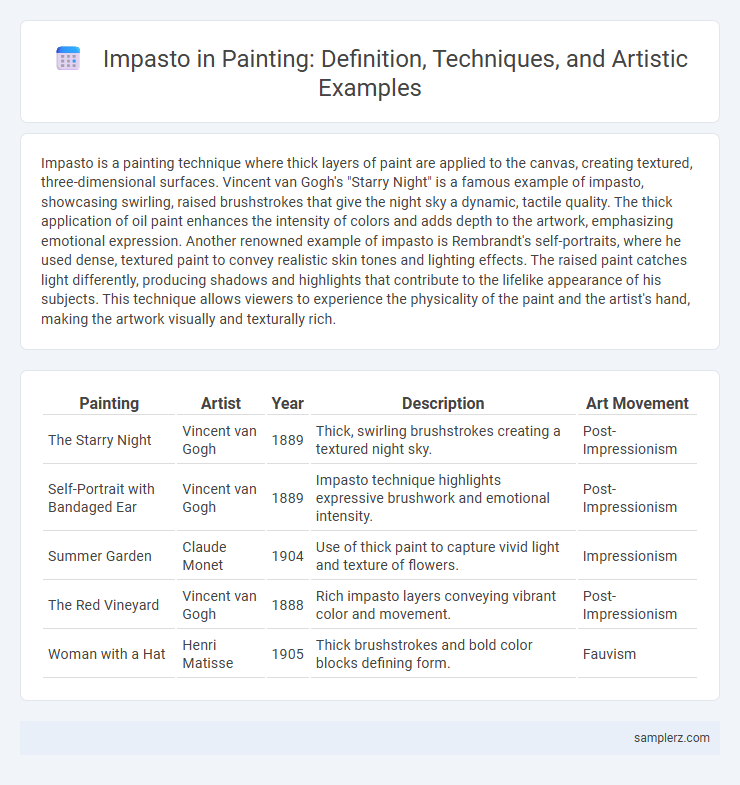Impasto is a painting technique where thick layers of paint are applied to the canvas, creating textured, three-dimensional surfaces. Vincent van Gogh's "Starry Night" is a famous example of impasto, showcasing swirling, raised brushstrokes that give the night sky a dynamic, tactile quality. The thick application of oil paint enhances the intensity of colors and adds depth to the artwork, emphasizing emotional expression. Another renowned example of impasto is Rembrandt's self-portraits, where he used dense, textured paint to convey realistic skin tones and lighting effects. The raised paint catches light differently, producing shadows and highlights that contribute to the lifelike appearance of his subjects. This technique allows viewers to experience the physicality of the paint and the artist's hand, making the artwork visually and texturally rich.
Table of Comparison
| Painting | Artist | Year | Description | Art Movement |
|---|---|---|---|---|
| The Starry Night | Vincent van Gogh | 1889 | Thick, swirling brushstrokes creating a textured night sky. | Post-Impressionism |
| Self-Portrait with Bandaged Ear | Vincent van Gogh | 1889 | Impasto technique highlights expressive brushwork and emotional intensity. | Post-Impressionism |
| Summer Garden | Claude Monet | 1904 | Use of thick paint to capture vivid light and texture of flowers. | Impressionism |
| The Red Vineyard | Vincent van Gogh | 1888 | Rich impasto layers conveying vibrant color and movement. | Post-Impressionism |
| Woman with a Hat | Henri Matisse | 1905 | Thick brushstrokes and bold color blocks defining form. | Fauvism |
Definition and Origins of Impasto Technique
Impasto is a painting technique characterized by the thick application of paint, creating textured, three-dimensional surfaces that catch light and add depth to the artwork. Originating in the Renaissance period, impasto was notably employed by artists like Titian and Rembrandt to emphasize brushstrokes and enhance the emotional intensity of their paintings. Contemporary artists continue to use impasto to evoke tactile sensations and highlight the physicality of paint, maintaining its historical significance in art.
Famous Artists Known for Impasto
Vincent van Gogh is renowned for his expressive use of impasto, especially in works like "Starry Night," where thick layers of oil paint create dynamic texture and movement. Rembrandt also employed impasto techniques, applying dense paint to highlight the play of light and shadow on his subjects' faces and clothing. Modern artists such as Anselm Kiefer use impasto to evoke physical and emotional depth, making the paint surface a crucial element of their visual storytelling.
Iconic Impasto Paintings in Art History
Impasto technique is vividly ejemplified in Vincent van Gogh's "Starry Night," where thick, swirling brushstrokes create dynamic texture and movement. Another iconic example is Rembrandt's self-portraits, showcasing rich, sculptural layers of paint that highlight emotional depth and realism. Jackson Pollock's drip paintings also incorporate impasto elements, emphasizing the physicality of paint and the artist's gesture.
Impasto in Contemporary Art
Impasto in contemporary art emphasizes textured brushstrokes and thick applications of paint, creating three-dimensional surfaces that enhance visual impact. Artists like Anselm Kiefer and Gerhard Richter employ impasto techniques to add depth and emotional intensity, blending abstract and figurative elements. This technique accentuates the physicality of paint, transforming canvases into dynamic, tactile experiences that invite viewers to explore materiality and form.
Notable Impressionist Impasto Works
Notable Impressionist impasto works include Vincent van Gogh's "Starry Night," where thick, swirling brushstrokes create dynamic textures and vibrant movement. Claude Monet's "Water Lilies" series showcases heavy paint application that enhances the shimmering effect of light on water surfaces. Pierre-Auguste Renoir's "Dance at Le Moulin de la Galette" uses impasto to emphasize lively figures and the play of sunlight among the crowd.
Post-Impressionist Masters of Impasto
Post-Impressionist masters of impasto, such as Vincent van Gogh and Paul Cezanne, utilized thick, textured brushstrokes to convey emotion and depth in their paintings. Van Gogh's "Starry Night" exemplifies impasto through its swirling, layered application of paint, creating a dynamic surface that captures movement. Cezanne's still lifes demonstrate impasto by emphasizing volume and form with dense, tactile paint layers that enhance the structural composition.
Abstract Expressionism and Impasto Application
Impasto in Abstract Expressionism is exemplified by artists like Jackson Pollock and Willem de Kooning, who used thick, textured layers of paint to convey intense emotion and dynamic movement. This technique enhances the tactile quality of the canvas, allowing brushstrokes and palette knife marks to become prominent visual elements. The impasto application creates a three-dimensional effect, emphasizing spontaneity and the physicality of paint on the surface.
Technical Examples: Tools and Materials for Impasto
Impasto technique in painting often utilizes palette knives and stiff-bristled brushes to apply thick layers of oil or acrylic paint, creating textured, three-dimensional surfaces. Artists frequently incorporate heavy-bodied paints and mediums such as modeling paste or gel mediums to enhance the paint's viscosity and maintain its raised form. This method allows for expressive brushstrokes and dynamic light reflections, emphasizing the tactile quality of the artwork.
Landscape Paintings Showcasing Impasto
Impasto technique creates striking texture in landscape paintings by applying thick layers of paint, enhancing depth and movement in scenes of nature. Artists like Vincent van Gogh used impasto to depict swirling skies and rugged terrains with vivid, palpable brushstrokes. Contemporary painters continue this tradition, bringing dynamic, three-dimensional effects to forest, mountain, and seascape compositions.
Portraiture Enhanced by Impasto Techniques
Impasto techniques in portraiture create a striking three-dimensional texture that emphasizes the emotional intensity of the subject. Notable artists like Vincent van Gogh and Lucian Freud utilized thick, layered paint to capture the depth of facial expressions and skin tones. This method highlights brushstrokes, adding dynamic movement and tactile richness to portraits.

example of impasto in painting Infographic
 samplerz.com
samplerz.com